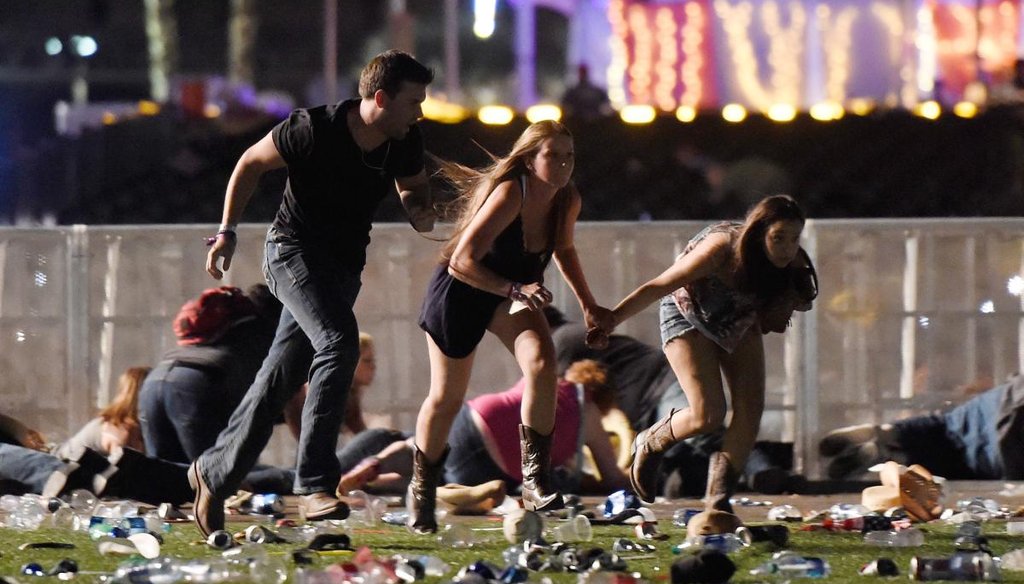Stand up for the facts!
Our only agenda is to publish the truth so you can be an informed participant in democracy.
We need your help.
I would like to contribute

People run from the Route 91 Harvest country music festival after apparent gun fire was hear on Oct. 1, 2017, in Las Vegas, Nev. A gunman has opened fire on a music festival in Las Vegas, leaving at least 50 people dead and more than 400 injured. (Getty)
With each mass shooting comes shock and heartbreak. But the enflamed rhetoric is not far behind.
We hear the same arguments about gun violence, mental health, how firearms should be regulated and what’s driving the prevalence of mass shootings with each attack.
PolitiFact has worked for years to research these topics to explain talking points used by all sides of the gun debate.
Here are some answers to questions you may have.
How do we define mass shootings?
There is no widely accepted definition of mass shootings. People use either broad or restrictive definitions of mass shootings to reinforce their stance on gun control.
After the 2012 Sandy Hook school shooting, Congress defined "mass killings" as three or more homicides in a single incident. The definition was intended to clarify when the U.S. attorney general could assist state and local authorities in investigations of violent acts and shootings in places of public use.
The Gun Violence Archive tracks gun deaths using media, law enforcement, government and commercial sources. Its data is based on a broader criteria: at least four people injured or killed in one location, not including the suspect.
Criminologists previously told PolitiFact that this group’s tally includes gang shootings and home invasion robberies.
How do we prevent mass shootings in schools?
The answers here are not simple, or cheap. We found experts and research that addressed many different ideas, from gun control to threat assessment measures to metal detectors.
We documented benefits and limitations with all of these ideas; read our full story.
When is a mass shooting in the United States considered terrorism?
A mass shooting needs to meet several criteria in order to be legally labeled as domestic terrorism. That definition applies to acts dangerous to human life that are a violation of U.S. or state criminal laws, which occur primarily within U.S. territorial jurisdiction and appear to be intended to:
-
intimidate or coerce a civilian population;
-
influence the policy of a government by intimidation or coercion; or
-
affect the conduct of a government by mass destruction, assassination, or kidnapping.
Recent mass shootings have led to debate on who should be charged with domestic terrorism.
For instance, the suspect who plowed his car into a crowd of counterprotesters in Charlottesville, Va., killing a woman, was not charged with terrorism but second-degree murder, among other charges. (The murder charge was elevated to first-degree murder months later.) Dylann Roof was charged for federal and state crimes, but not domestic terrorism, after shooting to death nine black churchgoers in Charleston, S.C., in 2015.
In the 2012 Aurora, Colo., movie theater shooting, James Holmes was found guilty on 165 counts that included first-degree murder, attempted murder and possession or control of an explosive or incendiary device — none was for domestic terrorism.
In other cases, such as the San Bernardino, Calif., attack or the Las Vegas concert massacre, the suspected shooters died in the event and therefore no charges were filed.
However, in the Oct. 31 truck attack on a bicycle path in New York, the suspect was charged with providing material support to a terrorist organization and for violence and destruction of a motor vehicle.
How do mass shootings in the U.S. compare with other countries?
Mass shootings do happen in other countries. But they do not happen with the same frequency as in the United States.
Two researchers — Jaclyn Schildkraut of the State University of New York in Oswego and H. Jaymi Elsass of Texas State University — analyzed mass shootings in 11 countries, covering the period from 2000-14. Aside from the United States, they looked at Australia, Canada, China, England, Finland, France, Germany, Mexico, Norway and Switzerland.
The United States has more mass shootings — and more people cumulatively killed or injured — than the other 10 nations combined, according to their research. While part of this is because the United States has a much bigger population than all but China, the difference can’t be explained by skewed population numbers alone.
When adjusted for population, the United States ranks in the upper half of their list of 11 countries, ranking higher than Australia, Canada, China, England, France, Germany and Mexico. The United States did rank lower than three countries (Norway, Finland and Switzerland) but they have populations so small that one or two mass-casualty events can produce a relatively high per capita rate.
Is a mental health crisis driving mass shootings?
While mass shootings can be tied to the mental instability of the shooter, mental instability is not a good predictor of mass shootings.
A study in the American Journal of Public Health found that databases that track gun homicides show that less than 5 percent of 120,000 gun-related killings in America between 2001 and 2010 were committed by people with a diagnosed mental illness.
The Centers for Disease Control and Prevention reported fluctuations over the years in the number of people who experienced serious psychological distress in the past 30 days. Since 2007, it has ranged from 2.7 percent to 3.8 percent in 2013. In both 2015 and 2016, the rate was 3.6 percent.
In the recent Texas church shooting, the killer had a history of mental illness. There have been policies to share that information more easily. Under President Barack Obama, the Social Security Administration issued a rule that stepped up its efforts to pass the names of those who lack the mental capacity to "manage his or her own affairs" to the National Instant Criminal Background Check System, which determines whether someone can legally buy a weapon.
President Donald Trump and Congress rescinded that rule on the grounds that it was overly broad.
One of the problems of turning the link between mental illness and mass shootings into effective public policy is that mass shootings are rare events. Gun violence researchers have found that the strongest predictors of violence in general include alcohol and drug abuse and a history of domestic violence.
Are lawmakers bought by the gun lobby?
The intensity of National Rifle Association members’ political sentiments on gun issues would be powerful even if the NRA didn’t spend as much as it does. Still, there’s no question that the National Rifle Association is an influential lobbying group, throwing a lot of money around the political process.
If you add together all of the NRA’s contributions to candidates, parties and leadership political action committees between 1998 and 2016, it comes to more than $13 million, according to calculations from the Center for Responsive Politics’ database.
Direct contributions are not even close to the biggest part of the NRA spending on policy influence, however.
During that same period, the NRA spent $144.3 million on outside spending. This consisted largely of "independent expenditures" — efforts "expressly advocating the election or defeat of a clearly identified candidate." Often these take the form of campaign ads, but they have to be carried out without coordinating with the candidates they are supporting.
In addition, the NRA has reported spending a cumulative $45.9 million on federal lobbying since 1998, both for its in-house operations and the outside consultants it has retained.
If you add it all up, the NRA has spent $203.2 million on political activities since 1998.
Are AR-15s/semi-automatics involved in recent mass shootings?
Yes. Semi-automatic rifles similar to the AR-15 have been used in high-profile and deadly mass shootings over the years in Aurora, Colo.; Roseburg, Ore.; San Bernadino, Calif.; Newtown, Conn.; Orlando; and in 2017, Las Vegas and Sutherland Springs, Texas.
The original AR-15 was a derivative of a rifle first developed by gunmaker ArmaLite in the 1950s. The AR refers to ArmaLite rifle, and does not stand for "assault rifle." U.S. armed forces use related models of this rifle as a standard-issue combat weapon, albeit usually with automatic capability, which is generally not legal for private citizens to own.
There are somewhere between 6 million and 10 million of these semi-automatic rifles in circulation in the United States. The NRA routinely refers to this style of semi-automatic weapon — as a "modern sporting rifle." Some politicians have referred to them as "weapons of war."
While an AR-15-style rifle is a semi-automatic design, keep in mind that a gun does not have to be a rifle to be semi-automatic. Many handguns also are semi-automatics, as are numerous models of hunting rifles and shotguns. The killer in the 2007 Virginia Tech shootings killed 32 people with two semi-automatic handguns.
What is the difference between a semi-automatic/automatic?
The term "semi-automatic" refers to any firearm designed to fire one bullet with one trigger squeeze, then automatically reload the chamber with a cartridge from a magazine and re-cock the firing mechanism to be ready to fire again.
Gun control arguments often focus on so-called black rifles, but the differences between those and any other semi-automatic rifles often are only cosmetic. Semi-automatic guns — whether they are black rifles, pistols, target rifles or otherwise — all largely operate the same way.
Automatic weapons, meanwhile, are different in that squeezing the trigger once fires cartridges repeatedly until the shooter releases it. These weapons are often described as machine guns.
The gunman who killed 58 people in Las Vegas on Oct. 1, 2017, used a device called a "bump stock" to allow a semi-automatic rifle to fire at a rate of speed similar to an automatic rifle.
While semi-automatic rifles are widely available, fully automatic weapons are not. You can still buy an automatic weapon, but their sale and ownership is highly regulated and exceptionally expensive.
Do you have a question about mass shootings that wasn't answered in this story? Email [email protected].
Our Sources
See the fact-checks linked within.





































